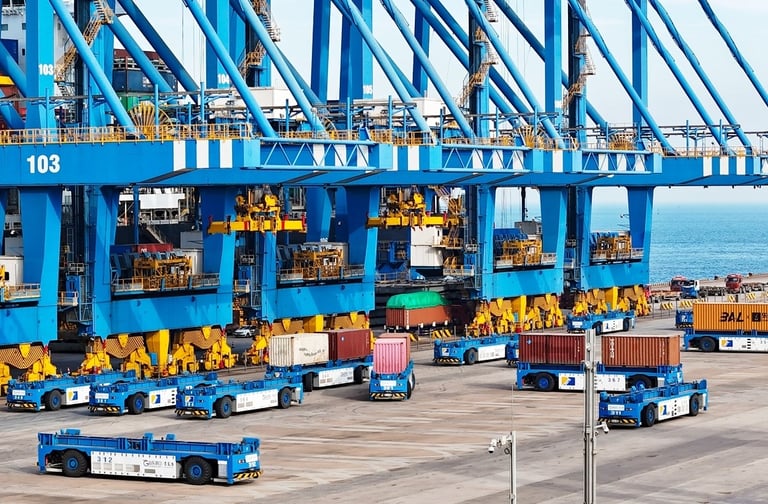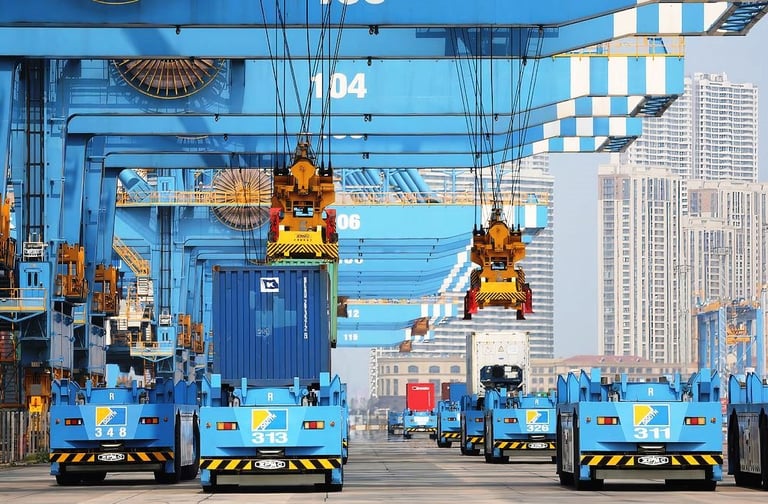Qingdao’s Automated Port: Pioneering Efficiency and Sustainability in Global Maritime Logistics
Qingdao’s fully automated port, Asia’s first, revolutionizes maritime logistics with AI, 5G, and hydrogen-powered cranes. Boasting world-record efficiency, it outshines Shanghai, Tianjin, and Ningbo-Zhoushan, setting a global standard for smart, sustainable ports.
LOGISTICSAUTOMOTIVE INNOVATIONS CLIMATE CHANGE
Teresa Ndlovu
7/16/20257 min read


The Qingdao New Qianwan Container Terminal (QQCTN), Asia’s first fully automated container terminal, has set a global benchmark for port automation since its launch in May 2017. Located in Qingdao, Shandong Province, this “ghost port” operates with minimal human intervention, leveraging artificial intelligence (AI), robotics, 5G connectivity, and eco-friendly technologies to achieve unparalleled efficiency. As China leads the world with 18 fully automated container terminals in operation and 27 more under construction or renovation, QQCTN stands out as a pioneer. This article explores QQCTN’s technological advancements, operational efficiencies, and sustainability features, comparing it to other notable automated ports in China, including Shanghai’s Yangshan Deepwater Port, Tianjin Port, and Ningbo-Zhoushan Port, to highlight its unique contributions and leadership in the global maritime industry.
Qingdao New Qianwan Container Terminal: A Technological Trailblazer
QQCTN, part of the Port of Qingdao, was the first fully automated terminal in Asia, with an annual throughput capacity of 5.2 million twenty-foot equivalent units (TEUs) and the ability to handle ultra-large container vessels up to 24,000 TEUs. Built in just three years, it features advanced technologies such as laser-guided automated guided vehicles (AGVs), remotely operated ship-to-shore (STS) cranes, automated stacking cranes (ASCs), and China’s first indigenously developed intelligent control system. Its efficiency, peaking at 60.6 TEUs per hour in 2024, has set 11 world records, making it a global leader in automated port operations.
Key Innovations:
38 Battery-Powered AGVs: These vehicles use laser scanners and over 20,000 ground transponders for precise navigation, with cycle-charging technology extending battery life from two to ten years, a world first.
Intelligent Control System: Introduced in the third phase (December 2023), this domestically developed system offers millisecond-level data refresh rates, quadrupling dispatch efficiency and eliminating reliance on foreign technology.
Hydrogen-Powered Cranes: The world’s first “hydrogen + 5G” smart ecological terminal reduces carbon emissions by 3.5 kg per TEU.
Automated Twist Lock System: A robotic system for twist lock assembly enhances efficiency by automating a traditionally manual process.
24/7 Operations: Laser scanning enables operations in complete darkness, reducing labor costs by 70% and boosting efficiency by 30%.
Performance Metrics: QQCTN’s average crane productivity is 36.2 containers per hour, with a peak of 60.6 TEUs per hour in 2024, surpassing traditional terminals by 50% and other automated terminals globally by a significant margin. It handled 6.88 million TEUs in Q1 2023, demonstrating robust throughput.
Comparison with Other Automated Ports in China
China’s dominance in port automation is evident, with terminals in Shanghai, Tianjin, and Ningbo-Zhoushan adopting similar technologies. Below, we compare QQCTN with these key automated ports to highlight its distinctive features and contributions.1. Shanghai Yangshan Deepwater Port (Phase IV)Overview: Located in Shanghai, the Yangshan Deepwater Port’s Phase IV, operational since December 2017, is the world’s largest automated container terminal by area, with a designed capacity of 6.3 million TEUs across seven berths. It serves as a critical hub for China’s Belt and Road Initiative, connecting to over 200 international shipping routes.
Technological Features:
Equipment: Features 26 STS cranes, 120 AGVs, and 80 ASCs, significantly more than QQCTN’s initial setup of 7 STS cranes, 38 AGVs, and 38 ASCs. However, Yangshan relies on a mix of foreign and domestic technologies, unlike QQCTN’s fully indigenous third-phase system.
Automation: Uses a terminal operating system (TOS) with AI and IoT integration, similar to QQCTN’s Navis N4 TOS, but lacks the hydrogen-powered cranes and automated twist lock systems unique to Qingdao.
Connectivity: Employs 5G and cloud computing for real-time operations, comparable to QQCTN’s 5G integration.
Overall Performance:
1.Yangshan’s efficiency is notable, with an average of 33 containers per hour per crane, but it falls short of QQCTN’s 36.2 and peak of 60.6 TEUs per hour. Its larger scale allows higher throughput, handling over 25 million TEUs annually across all phases, compared to QQCTN’s 5.2 million TEU capacity.
Comparison:
Scale vs. Efficiency: Yangshan’s larger infrastructure supports higher throughput, but QQCTN’s superior per-crane efficiency and world-record performances highlight its technological edge.
Innovation: QQCTN’s hydrogen-powered cranes and indigenous control system give it a sustainability and technological independence advantage over Yangshan, which still uses some foreign components.
Construction Speed: QQCTN’s three-year construction timeline outpaces Yangshan’s longer development, making it a model for rapid deployment.
2. Tianjin Port (Section C, Beijiang Area)Overview: Tianjin Port’s fully automated terminal in the Beijiang Area, operational since October 2021, is China’s first fully automated terminal built entirely with domestic technology. With a capacity of 2.5 million TEUs, it serves as a key hub in northern China, connecting to Belt and Road routes.
Technological Features:
Equipment: Employs 21 STS cranes, 76 AGVs, and 64 ASCs, outnumbering QQCTN’s initial setup but comparable to its planned expansion to six berths.
Digital Twin Technology: Uses a digital twin system for real-time monitoring and predictive maintenance, a feature not yet reported at QQCTN.
Green Initiatives: Incorporates wind and solar power, achieving zero carbon emissions, similar to QQCTN’s hydrogen-powered cranes but with a different renewable energy focus.
Performance: Tianjin’s efficiency averages 30 containers per hour per crane, lower than QQCTN’s 36.2. Its smaller capacity limits its throughput compared to Qingdao’s 6.88 million TEUs in Q1 2023 alone.
Comparison:
Technological Independence: Both ports use fully domestic systems, but QQCTN’s earlier adoption (third phase, 2023) and broader range of innovations (e.g., twist lock automation) give it an edge.
Sustainability: Tianjin’s wind and solar focus complements QQCTN’s hydrogen technology, but Qingdao’s “hydrogen + 5G” model is unique globally.
Efficiency: QQCTN’s record-breaking crane productivity surpasses Tianjin’s, making it a leader in operational performance.
3. Ningbo-Zhoushan Port (Meishan Terminal)Overview: The Meishan Terminal at Ningbo-Zhoushan Port, partially automated since 2019, has a capacity of 2 million TEUs and is expanding to full automation. It is a major hub for Southeast Asian and trans-Pacific routes, handling 33 million TEUs across the port in 2023.
Features:
Equipment: Uses 12 STS cranes, 50 AGVs, and 40 ASCs, with plans to scale up. Unlike QQCTN, it relies on a mix of foreign and domestic systems.
Automation: Employs AI-driven TOS and 5G, similar to QQCTN, but lacks advanced features like hydrogen cranes or automated twist lock systems.
Smart Logistics: Features an intelligent gate system for automated truck processing, comparable to QQCTN’s radioactive gate inspection.
Meishan’s crane efficiency averages 28 containers per hour, significantly lower than QQCTN’s 36.2. Its throughput is robust but spread across a larger, partially automated facility, diluting its automated terminal’s impact compared to QQCTN’s focused automation.
Comparison:
Technological Maturity: QQCTN’s fully automated, domestically developed systems and unique innovations outpace Meishan’s partial automation and reliance on foreign technology.
Efficiency and Scale: QQCTN’s higher crane productivity and focused automation make it more efficient per unit, though Ningbo-Zhoushan’s overall port throughput is higher due to its larger scale.
Sustainability: QQCTN’s hydrogen-powered cranes provide a greener edge over Meishan’s diesel-dependent operations.
Comparative Analysis: Qingdao’s Leadership in AutomationEfficiency:
QQCTN: Leads with 36.2 containers per hour (peak 60.6), surpassing Yangshan (33), Tianjin (30), and Meishan (28). Its 11 world records underscore its dominance.
Others: Yangshan’s larger scale supports higher total throughput, but its per-crane efficiency lags. Tianjin and Meishan trail in both efficiency and throughput due to smaller capacities or partial automation.
Technological Independence:
QQCTN: Achieved full domestic technology in its third phase (2023), using over 28,000 homegrown components, a milestone shared only with Tianjin’s Section C.
Others: Yangshan and Meishan still rely on some foreign systems, limiting their technological sovereignty compared to Qingdao and Tianjin.
Sustainability:
QQCTN: Pioneers hydrogen-powered cranes and zero-emission operations, setting a global standard for green ports.
Others: Tianjin’s wind and solar initiatives are notable, but Yangshan and Meishan lag, with Yangshan using some diesel-powered equipment and Meishan not yet fully automated.
Scalability and Replication:
QQCTN: Its three-year construction timeline and compatibility-focused design make it a replicable model, influencing terminals in Shanghai, Tianjin, and beyond.
Others: Yangshan’s larger scale required longer construction (over 5 years), while Tianjin and Meishan are still scaling up automation, limiting their immediate replicability.
Economic Impact:
QQCTN: Services 175 shipping routes, including 65 along the Belt and Road, and leads in sea-rail transport, handling over 1 million TEUs annually. Its labor cost reduction (70%) and efficiency gains (30%) set a high economic benchmark.
Others: Yangshan’s global connectivity (200+ routes) and higher throughput give it a broader economic footprint, but QQCTN’s efficiency per TEU is unmatched. Tianjin and Meishan contribute significantly but are constrained by smaller capacities or partial automation.
Challenges and Future Prospects, While QQCTN leads in efficiency and innovation, challenges persist across China’s automated ports:
Standardization: Integrating diverse automation systems across ports remains complex, as noted by industry experts. QQCTN’s indigenous system addresses this for future projects but requires broader adoption.
Initial Costs: High capital expenditures for automation (e.g., Yangshan’s massive infrastructure) pose barriers, though QQCTN’s rapid construction mitigates this.
Labor Resistance: Automation reduces jobs, potentially causing pushback, though QQCTN’s minimal workforce (9 vs. 60 for unloading) demonstrates a viable transition model.
Looking ahead, QQCTN plans to expand to six berths, targeting 40 containers per hour per crane and further integrating remote driving and AI analytics. Yangshan aims to enhance its 5G and IoT capabilities, while Tianjin and Meishan focus on full automation and renewable energy integration. QQCTN’s “Qingdao Model” is likely to influence these developments, offering a blueprint for rapid, sustainable, and efficient port automation.
The Qingdao New Qianwan Container Terminal stands as China’s and Asia’s premier automated port, distinguished by its world-record efficiency, fully indigenous technology, and pioneering sustainability features like hydrogen-powered cranes. Compared to Shanghai’s Yangshan, Tianjin’s Beijiang, and Ningbo-Zhoushan’s Meishan terminals, QQCTN excels in per-crane productivity, technological independence, and green innovation, despite Yangshan’s larger scale. Its rapid construction, cost efficiency, and replicability make it a global model for smart ports, driving China’s dominance in the race toward Port 4.0. As other Chinese ports continue to automate, QQCTN’s innovations will shape the future of maritime logistics, balancing efficiency, sustainability, and economic impact.


Future
© 2025. All rights reserved.


